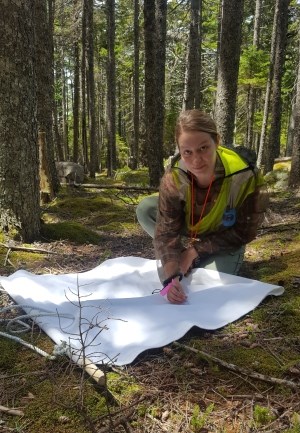Last updated: January 12, 2022
Article
Research Brief: Historical and Short-term impacts of Fire on Tick-borne Disease Transmission in Acadia National Park

Courtesy of Sara McBride
Residents of the Acadia region recognize the growing burden on human health posed by ticks, and a majority of visitors are concerned about exposure to tick-carried diseases. National Park Service staff are interested in ways they might be able to manage habitat to reduce the risk of Lyme disease.
Allison Gardner is researching the distribution of the black-legged tick and Lyme prevalence in Acadia, and how both are influenced by forest characteristics and fire. By altering vegetation, fire may affect the abundance of tick hosts like chipmunks, mice, and deer. Acadia’s history of fire provides a natural experiment to study this question. For example, the Fire of 1947 dramatically altered the structure and species composition on more than 10,000 acres of forest on Mount Desert Island, as aspen and birch replaced spruce-fir forest. The leaves dropped by the aspen and birch create a forest floor environment conducive to the survival of ticks and their small-mammal hosts.
Gardner sampled ticks at 1947 burned and unburned sites, and at areas in the park that are on a rotating cycle of prescribed fire management. Gardner, graduate student Sara McBride, and undergraduate Lucy Guarnieri counted ticks on small mammals caught in live traps, looked for deer scat, and measured conditions such as temperature, humidity, leaf litter depth, and vegetation density. Ticks were tested for Lyme disease in a laboratory.
Research currently going on in Acadia National Park. Keep checking back with this page for future updates and findings on this project
